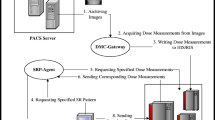Abstract
The U.S. National Press has brought to full public discussion concerns regarding the use of medical radiation, specifically x-ray computed tomography (CT), in diagnosis. A need exists for developing methods whereby assurance is given that all diagnostic medical radiation use is properly prescribed, and all patients’ radiation exposure is monitored. The “DICOM Index Tracker©” (DIT) transparently captures desired digital imaging and communications in medicine (DICOM) tags from CT, nuclear imaging equipment, and other DICOM devices across an enterprise. Its initial use is recording, monitoring, and providing automatic alerts to medical professionals of excursions beyond internally determined trigger action levels of radiation. A flexible knowledge base, aware of equipment in use, enables automatic alerts to system administrators of newly identified equipment models or software versions so that DIT can be adapted to the new equipment or software. A dosimetry module accepts mammography breast organ dose, skin air kerma values from XA modalities, exposure indices from computed radiography, etc. upon receipt. The American Association of Physicists in Medicine recommended a methodology for effective dose calculations which are performed with CT units having DICOM structured dose reports. Web interface reporting is provided for accessing the database in real-time. DIT is DICOM-compliant and, thus, is standardized for international comparisons. Automatic alerts currently in use include: email, cell phone text message, and internal pager text messaging. This system extends the utility of DICOM for standardizing the capturing and computing of radiation dose as well as other quality measures.







Similar content being viewed by others
References
The Joint Commission: The Joint Commission Sentinel Event Policy and Procedures, Oakbrook Terrace, IL, 2007
Agency for Healthcare Research and Quality, Available at http://www.ahrq.gov/. Accessed 03 January, 2010
National Quality Measures Clearinghouse. Available at http://www.guideline.gov/browse/xrefnqmc.aspx. Accessed 03 January, 2010
FDA News Release. ‘FDA makes interim recommendations to address concerns of excess radiation exposure during CT Perfusion’, Dec 7, 2009. Available at http://www.fda.gov/NewsEvents/Newsroom/PressAnnouncements/2009/ucm193190.htm. Accessed 18 January, 2010
Opreanu RC, Kepros JP: Radiation doses associated with cardiac computed tomography angiography. JAMA 301(22):2324–2325, 2009
Brenner DJ, Hall EJ: Computed tomography: an increasing source of radiation exposure. N Engl J Med 357:2277–2284, 2007
Amis Jr, ES, Butler PF, Applegate KE, Birnbaum SB, Brateman LF, Hevezi JM, Mettler FA, Morin RL, Pentecost MJ, Smith GG, Strauss KJ, Zeman RK: American College of Radiology white paper on radiation dose in medicine. J. Am Coll Radiol 4:272–284, 2007
Center for Devices and Radiological Health, U.S. Food and Drug Administration, White Paper: Initiative to Reduce Unnecessary Radiation Exposure from Medical Imaging, 2010. http://www.fda.gov/downloads/Radiation-EmittingProducts/RadiationSafety/RadiationDoseReduction/UCM200087.pdf
Langer S: Issues Surrounding PACS Archiving to External. Third-Party DICOM Archives. J Digit Imaging 22(1):48–52, 2009
DICOM Structured Report WG-08 and WG-15 Supplement 94, WG-21 CT Dose SR
Reiner BI: The challenges, opportunities, and imperative of structured reporting in medical imaging. J Digit Imaging 22(6):1–7, 2009
DICOM Standards, available at ftp://medical.nema.org/medical/dicom/2009/, Accessed 23 July, 2010
Prevedello LM, Sodickson AD, Andriole KP, Khorasani R: IT tools will be critical in helping reduce radiation exposure from medical imaging. J Am Coll Radiol. 6:125–126, 2009
Peter MB, Schueler B, Pavlicek W, Langer S, Wang SS, Hu MQ, Wu T: Quality assurance and radiation dose monitoring for digital mammography using the dose index tracker, 2010. Annual Meeting of the Society for Imaging Informatics in Medicine (SIIM), Minneapolis, Minnesota, June 3–6, 2010
Yakoumakis E, Tsalafoutas IA, Nikolaou D, Nazos I, Koulentianos E, Proukakis C: Differences in effective dose estimation from dose-area product and entrance surface dose measurements in intravenous urography. Br J Radiol 74:727–34, 2001
Einstein AJ, Henzlova MJ, Rajagopalan S: Estimating risk of cancer associated with radiation exposure from 64-slice computed tomography cornoary angiography. JAMA 298:317–323, 2007
The Diagnostic Imaging Council CT Committee: The measurement, reporting, and management of radiation dose in CT, Report No. 96, AAPM, 2008
Hu M, Pavlicek W, Liu P, Zhang M, Langer S, Wang S, Place V, Miranda R, Wu T: “Efficiency Metrics for Imaging Device Productivity”, revised and resubmitted to RadioGraphics at 07/16/2010
WORKPACKAGE 4 -Efficacy and safety in high individual dose examination, the European SENTINEL(Safety and Efficacy for New Techniques and Imaging using New Equipment to Support European Legislation) project, http://www.dimond3.org/
Vano E, Padovani R, Neofotistou V, Tsapaki V, Kottou S, Ten JI, Fernandez JM, Faulkner K: Improving patient dose management using DICOM header information. The European SENTINEL experience. Proceedings of the International Special Topic Conference on Information Technology in Biomedicine. Available at http://medlab.cs.uoi.gr/itab2006/proceedings/Medical%20Imaging/149.pdf, Accessed 22 January 2010
Langer S, Charboneau N, French T: DCMTB: A virtual appliance DICOM toolbox. J Digit Imaging. http://www.springerlink.com/content/34l2635303wg57l5, 2009
Prieto C, Vano E, Ten JI, Fernandez JM, Iniguez AI, Arevalo N, Litcheva A, Crespo E, Floriano A, Martinez D: Image retake analysis in digital radiography using DICOM header information. J Digit Imaging 22(4):393–399, 2009
Laprise NK, Hanusik R, FitzGerald TJ, Rosen N, White KS: Developing a multi-institutional PACS archive and designing processes to manage the shift from a film to a digital-based archive. J Digit Imaging 22(1):15–24, 2009
Khodadadegan Y, Zhang M, Pavlicek W, Paden RG, Chong B, Schueler BA, Fetterly KA, Langer SG, Wu T: Automatic monitoring of localized skin dose with fluoroscopic and interventional procedures. revised and resubmitted to J Digit Imaging at 7/9/2010
Author information
Authors and Affiliations
Corresponding author
Rights and permissions
About this article
Cite this article
Wang, S., Pavlicek, W., Roberts, C.C. et al. An Automated DICOM Database Capable of Arbitrary Data Mining (Including Radiation Dose Indicators) for Quality Monitoring. J Digit Imaging 24, 223–233 (2011). https://doi.org/10.1007/s10278-010-9329-y
Published:
Issue Date:
DOI: https://doi.org/10.1007/s10278-010-9329-y




